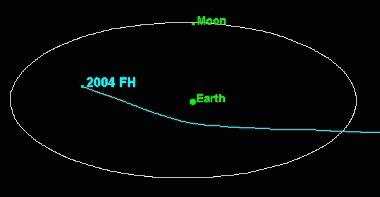2004 FH Índice Descoberta | Órbita | Veja também | Referências Ligações externas | Menu de navegação«Recently Discovered Near-Earth Asteroid Makes Record-breaking Approach to Earth»«MPEC 2004-F24 : 2004 FH»2004 FHMPEC 2004-F24Images of 2004 FH
AsteroidesAsteroides AtonAsteroides próximos da Terra
asteroide próximo da Terraasteroides Atonmagnitude absolutadiâmetrosuperfície terrestre18 de março2004UTC15 de março2004LINEARNASAórbitaexcentricidadesemieixo maiorUAperiélioSolafélio
(function()var node=document.getElementById("mw-dismissablenotice-anonplace");if(node)node.outerHTML="u003Cdiv class="mw-dismissable-notice"u003Eu003Cdiv class="mw-dismissable-notice-close"u003E[u003Ca tabindex="0" role="button"u003Eocultaru003C/au003E]u003C/divu003Eu003Cdiv class="mw-dismissable-notice-body"u003Eu003Cdiv id="localNotice" lang="pt" dir="ltr"u003Eu003C/divu003Eu003C/divu003Eu003C/divu003E";());
2004 FH
Saltar para a navegação
Saltar para a pesquisa
| 2004 FH | |
|---|---|
 | |
| O asteroide 2004 FH em trânsito perto da Terra (ponto central seguido pela sequência). O objeto que pisca é um satélite artificial. | |
| Data da descoberta | 15 de março de 2004 |
| Descoberto por | LINEAR |
Elementos orbitais | |
Semieixo maior | 0,818 UA |
Perélio | 0,582 UA |
Afélio | 1,054 UA |
Excentricidade | 0,818 |
Anomalia média | 28,04 ° |
Inclinação | 0,288° |
Longitude do nó ascendente | 264,4 ° |
Argumento do periastro | 62,95 ° |
| Características físicas | |
| Dimensões | 30 metros[1] km |
Magnitude absoluta | 26,2 |
ver | |
2004 FH é um asteroide próximo da Terra que faz parte da família de asteroides Aton. O objeto possui uma magnitude absoluta de 26,2 e tem um diâmetro de aproximadamente 30 metros.[1] Ele passou apenas a 43 000 km acima da superfície terrestre em 18 de março de 2004, às 22:08 UTC.[1]
Índice
1 Descoberta
2 Órbita
3 Veja também
4 Referências
5 Ligações externas
Descoberta |
2004 FH foi descoberto no dia 15 de março de 2004 pelo LINEAR, programa financiado pela NASA.[2]
Órbita |
A órbita de 2004 FH tem uma excentricidade de 0,6142 e possui um semieixo maior de 0,818 UA. O seu periélio leva o mesmo a uma distância de 0,582 UA em relação ao Sol e seu afélio a 1,054 UA.

Veja também |
- Lista de asteroides
- Lista de asteroides notáveis
Referências
↑ abc «Recently Discovered Near-Earth Asteroid Makes Record-breaking Approach to Earth» (em inglês). NASA's Near Earth Object Program Office. Consultado em 28 de novembro de 2014
↑ «MPEC 2004-F24 : 2004 FH» (em inglês). NASA/JPL Near-Earth Object Program Office. Consultado em 28 de novembro de 2014
Ligações externas |
- MPEC 2004-F24
- Images of 2004 FH
Categorias:
- Asteroides
- Asteroides Aton
- Asteroides próximos da Terra
(window.RLQ=window.RLQ||[]).push(function()mw.config.set("wgPageParseReport":"limitreport":"cputime":"0.200","walltime":"0.262","ppvisitednodes":"value":407,"limit":1000000,"ppgeneratednodes":"value":0,"limit":1500000,"postexpandincludesize":"value":10537,"limit":2097152,"templateargumentsize":"value":533,"limit":2097152,"expansiondepth":"value":6,"limit":40,"expensivefunctioncount":"value":0,"limit":500,"unstrip-depth":"value":0,"limit":20,"unstrip-size":"value":2762,"limit":5000000,"entityaccesscount":"value":1,"limit":400,"timingprofile":["100.00% 217.393 1 -total"," 65.90% 143.253 1 Predefinição:Info/Asteroide"," 29.36% 63.826 1 Predefinição:Referências"," 24.73% 53.767 2 Predefinição:Citar_web"," 7.19% 15.633 1 Predefinição:Valor_Wikidata"," 4.16% 9.053 1 Predefinição:Categorização_AD_e_AB_de_outras_wikis"," 2.06% 4.485 1 Predefinição:Links"," 1.30% 2.826 1 Predefinição:Commons"," 1.27% 2.752 1 Predefinição:Esconder_link_para_editar_seção"],"scribunto":"limitreport-timeusage":"value":"0.076","limit":"10.000","limitreport-memusage":"value":2353519,"limit":52428800,"cachereport":"origin":"mw1334","timestamp":"20190419132129","ttl":2592000,"transientcontent":false);mw.config.set("wgBackendResponseTime":123,"wgHostname":"mw1332"););